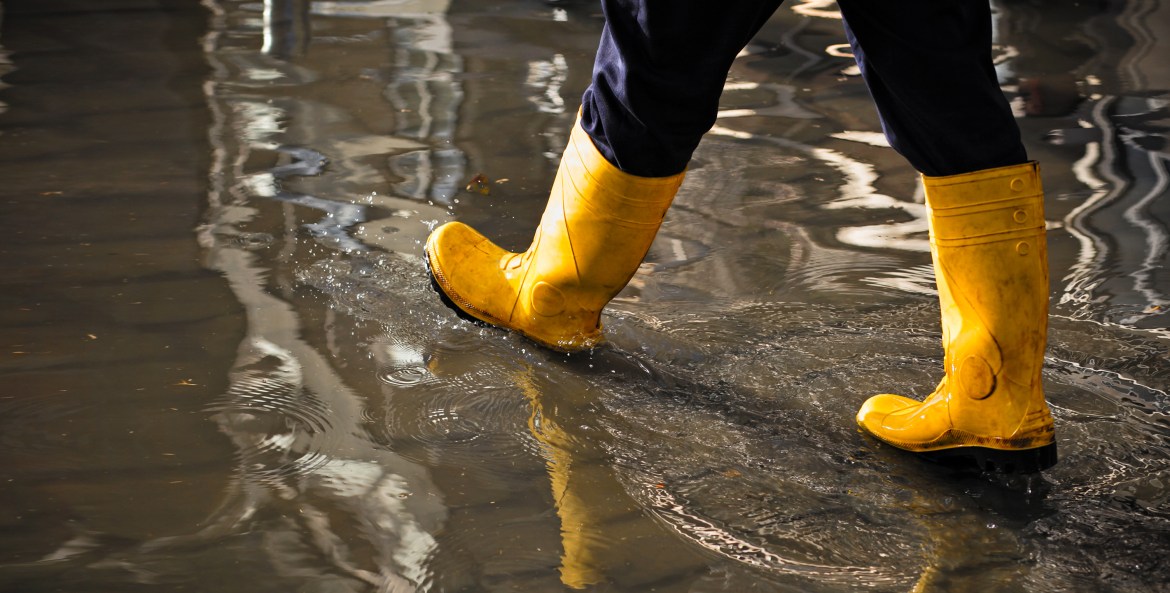Water seems relatively harmless, until it streams into your home and you end up with a flooded house—complete with drenched walls, floors, furniture, and clothing. Floods are more common in certain parts of the country, but they actually strike in all 50 states. When a flood hits, knowing how to respond can make all the difference.
What steps should I take after my home floods?
After a flood, clean-up and repairs begin. While you may feel eager to make quick progress, keep safety top of mind and call in experts if necessary. Take the following steps to kickstart your home’s journey to recovery:
- Return to your home only after authorities confirm that it’s safe, and only enter if there’s no structural damage.
- Don’t drink tap water until the local government or utility provider confirms that the local water is safe to drink.
- Wear protective clothing, gloves, and boots to guard against possibly contaminated water.
- Be on the lookout for rodents, snakes, and other critters that the floodwaters may have swept into your home.
- Shut off the gas and electric and any power sources going to flooded areas, and wear rubber boots to avoid electric shock.
- Don’t turn on the heat or air conditioning, which can spread mold through your home’s duct system. If your home’s venting systems are contaminated with water, they’ll need to be professionally cleaned.
- Report any downed power lines to your local utility company.
- Call an electrician, who can assess the state of your electrical system.
- Contact a plumber or septic tank pumping company if you suspect your septic tank is damaged or filled with debris. If your septic tank is sinking into the soil, for example, or is unable to accept water, bring in an expert to inspect it.
- Contact a plumber if you see any damaged pipes.
- Pump water out of your home, but only after the water outdoors has receded. You’ll want to get rid of it as quickly as possible, but take care to pump the water out of your basement slowly—about one-third of the water each day—to avoid damaging your home’s foundation. Contact a flood and water damage expert if you need help.
- After the water has receded or has been pumped out of your home, unplug your appliances. Then have a technician inspect their integrity before reconnecting them for use.
- Start drying out your home using a wet vac, a shop vac, fans, and dehumidifiers. Open windows and doors to get fresh air circulating.
- Toss out any food or medications that were exposed to floodwater.
- Use hot, soapy water to clean dishes and other items, and discard anything made of soft plastic.
- Call contractors to begin repairing any flood damage to your home. Drywall or plaster, insulation, wood framing, floor coverings, and other parts of your home may need to be repaired or replaced.
What should I do if I have flood insurance?
Most homeowners insurance doesn’t cover flooding—you need flood-specific insurance.
If you have flood coverage, you should:
- Submit a claim with your flood insurance company. An adjuster will need to visit your home to assess the damage. If you can’t remember the name of your insurance company, call the National Flood Insurance Program’s hotline at 800-427-4661.
- Gather information that will be helpful to your insurer including your policy number, photos of your damaged property, repair estimates from contractors, and receipts for repairs already completed. Smart Tip: Make the claims process easier by completing a home inventory.
- Make a list of your damaged personal property, including a description of each item, the brand name, the model and serial number of appliances, and what a replacement will cost (including receipts, if available).
- List any areas of structural damage to your home, so you can point them out when the adjuster arrives.
- Sign the Proof of Loss provided by the adjuster—which is based on his or her assessment—and return it to your insurance company within 60 days of the loss.
- Contact your insurance company if you find additional damage so you can file for additional payment.
Once your insurance claim is approved, payment will be sent to you.
Will my renters insurance cover flood damage to my home?
Most renter’s insurance policies do not cover flood damage. However, renters can buy flood coverage, and it’s an especially good idea if you live on a lower floor.
What should I do if I don’t have flood insurance?
If your home floods and you don’t have flood coverage, help may be available. If the federal government declares your community a disaster area, you can apply for a FEMA Disaster Grant through the agency’s Individuals and Households Program. FEMA may provide up to $33,000 for home repairs and temporary housing. Assistance from FEMA doesn’t have to be repaid, and it’s not considered taxable income. Visit DisasterAssistance.gov to enter your city and find out if you’re eligible for help. To apply for assistance, visit DisasterAssistance.gov or call 800-621-3362 or 800-462-7585 (TTY).
Keep in mind that if you live in a Special Flood Hazard Area, you’re required to carry flood insurance. FEMA may provide emergency dollars, but you’ll need to submit a claim to your insurance company. Once your insurance claim is paid, you must repay FEMA.
Homeowners who live in a declared disaster area but aren’t able to get FEMA help can apply for another program, offered through the U.S. Small Business Administration (SBA). The SBA provides loans of up to $200,000 to homeowners to repair or replace a flooded home or business. The SBA also offers loans of up to $40,000 to replace damaged or destroyed belongings, such as furniture, clothing, and cars. Apply by contacting the SBA.
Does auto insurance cover flood-damaged cars?
If you have comprehensive auto insurance, your policy most likely covers flood damage.
